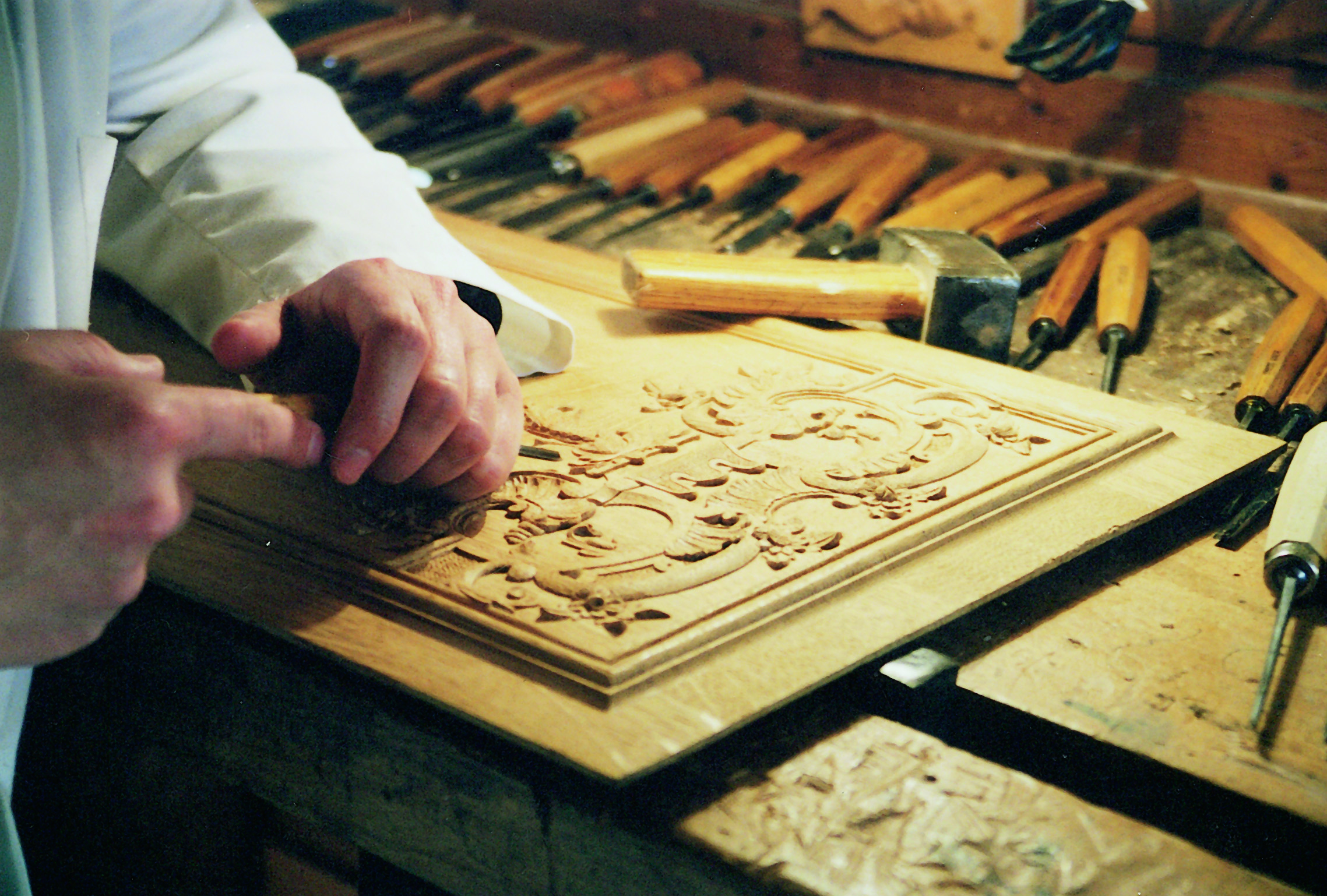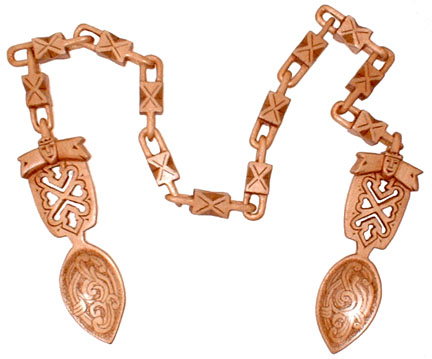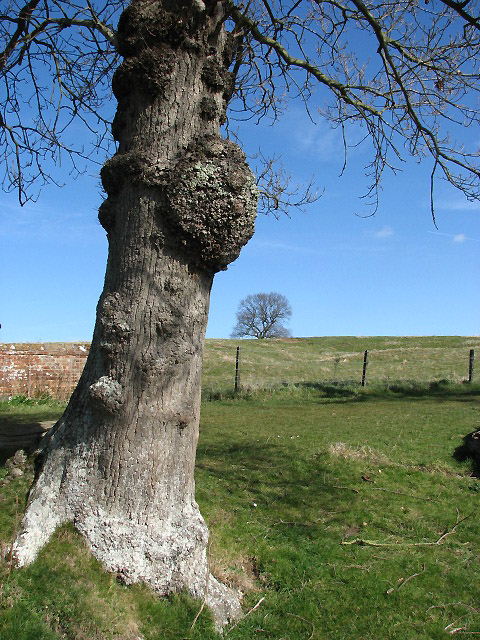|
Treen
Treen (literally "of a tree") is a generic name for small handmade functional household objects made of wood. Treen is distinct from furniture, such as chairs, and cabinetry, as well as clocks and cupboards. Before the late 17th century, when silver, pewter, and ceramics were introduced for tableware, most small household items, boxes and tableware were carved from wood. Today, treen is highly collectable for its patina and tactile appeal. Anything from wooden plates and bowls, snuff boxes and needle cases, spoons and stay busks to shoehorns and chopping boards can be classed as treen. Domestic and agricultural wooden tools are also usually classed with treen. Before the advent of cheap metal wares in industrialized societies, and later plastic, wood played a much greater part as the raw material for common objects. Turning and carving were the key manufacturing techniques. The selection of wood species was important, and close-grained hardwoods such as box, beech and sycamore w ... [...More Info...] [...Related Items...] OR: [Wikipedia] [Google] [Baidu] |
Wood Carving
Wood carving (or woodcarving) is a form of woodworking by means of a cutting tool (knife) in one hand or a chisel by two hands or with one hand on a chisel and one hand on a mallet, resulting in a wooden figure or figurine, or in the sculpture, sculptural ornamentation of a wooden object. The phrase may also refer to the finished product, from individual sculptures to hand-worked mouldings composing part of a tracery. The making of sculpture in wood has been History of wood carving, extremely widely practised, but does not survive undamaged as well as the other main materials like Stone sculpture, stone and bronze, as it is vulnerable to decay, insect damage, and fire. Therefore, it forms an important hidden element in the art history of many cultures. Outdoor wood sculptures do not last long in most parts of the world, so it is still unknown how the totem pole tradition developed. Many of the most important sculptures of China and Japan, in particular, are in wood, and so are th ... [...More Info...] [...Related Items...] OR: [Wikipedia] [Google] [Baidu] |
Lovespoon
A lovespoon is a wooden spoon decoratively carved that was traditionally presented as a gift of romantic intent. The spoon is normally decorated with symbols of love, and was intended to reflect the skill of the carver. Due to the intricate designs, lovespoons are no longer used as functioning spoons and are now decorative craft items. Origins The lovespoon is a traditional Welsh craft that dates back to the seventeenth century. Over generations, decorative carvings were added to the spoon and it lost its original practical use and became a treasured decorative item to be hung on a wall. The earliest known dated lovespoon from Wales, displayed in the St Fagans National History Museum near Cardiff, is from 1667, although the tradition is believed to date back long before that. The earliest surviving example of a lovespoon worldwide originates from Germany, and is dated as 1664. Symbols The lovespoon was given to a young woman by her suitor, to prove to her father that he was cap ... [...More Info...] [...Related Items...] OR: [Wikipedia] [Google] [Baidu] |
Burl
A burl (American English) or burr (British English) is a tree growth in which the grain has grown in a deformed manner. It is commonly found in the form of a rounded outgrowth on a tree trunk or branch that is filled with small knots from dormant buds. Burl formation is typically a result of some form of stress such as an injury or a viral or fungal infection. More scientifically, a burl is “the result of hyperplasia, a greatly abnormal proliferation of xylem production by the vascular cambium”. Burls yield a very peculiar and highly figured wood sought after in woodworking, and some items may reach high prices on the wood market. Poaching of burl specimens and damaging the trees in the process poses a problem in some areas. Description A burl results from a tree undergoing some form of stress. It may be caused by a virus, fungus or ''Agrobacterium tumefaciens'' entering the plant through an injury. Most burls grow beneath the ground, attached to the roots as a type ... [...More Info...] [...Related Items...] OR: [Wikipedia] [Google] [Baidu] |
Wood Turning
Woodturning is the craft of using a wood lathe with hand-held tools to cut a shape that is symmetrical around the axis of rotation. Like the potter's wheel, the wood lathe is a mechanism that can generate a variety of forms. The operator is known as a ''turner'', and the skills needed to use the tools were traditionally known as ''turnery''. In pre-industrial England, these skills were sufficiently difficult to be known as "the mysteries of the turners' guild." The skills to use the tools by hand, without a fixed point of contact with the wood, distinguish woodturning and the wood lathe from the machinist's lathe, or metal-working lathe. Items made on the lathe include tool handles, candlesticks, egg cups, knobs, lamps, rolling pins, cylindrical boxes, Christmas ornaments, bodkins, knitting needles, needle cases, thimbles, pens, chessmen, spinning tops; legs, spindles, and pegs for furniture; balusters and newel posts for architecture; baseball bats, hollow forms such as w ... [...More Info...] [...Related Items...] OR: [Wikipedia] [Google] [Baidu] |
Chair
A chair is a type of seat, typically designed for one person and consisting of one or more legs, a flat or slightly angled seat and a back-rest. It may be made of wood, metal, or synthetic materials, and may be padded or upholstered in various colors and fabrics. Chairs vary in design. An armchair has armrests fixed to the seat; a recliner is upholstered and features a mechanism that lowers the chair's back and raises into place a footrest; a rocking chair has legs fixed to two long curved slats; and a wheelchair has wheels fixed to an axis under the seat. Etymology ''Chair'' comes from the early 13th-century English word ''chaere'', from Old French ("chair, seat, throne"), from Latin ("seat"). History The chair has been used since antiquity, although for many centuries it was a symbolic article of state and dignity rather than an article for ordinary use. "The chair" is still used as the emblem of authority in the House of Commons in the United Kingdom and Canad ... [...More Info...] [...Related Items...] OR: [Wikipedia] [Google] [Baidu] |
Lignum Vitae
Lignum vitae (), also called guayacan or guaiacum, and in parts of Europe known as Pockholz or pokhout, is a wood from trees of the genus '' Guaiacum''. The trees are indigenous to the Caribbean and the northern coast of South America (e.g., Colombia and Venezuela) and have been an important export crop to Europe since the beginning of the 16th century. The wood was once very important for applications requiring a material with its extraordinary combination of strength, toughness, and density. It is also the national tree of the Bahamas, and the Jamaican national flower. The wood is obtained chiefly from '' Guaiacum officinale'' and '' Guaiacum sanctum'', both small, slow-growing trees. All species of the genus ''Guaiacum'' are now listed in Appendix II of CITES (the Convention on International Trade in Endangered Species of Wild Fauna and Flora) as potentially endangered species. ''G. sanctum'' is listed as Near Threatened by the IUCN Red List. Demand for the wood has been re ... [...More Info...] [...Related Items...] OR: [Wikipedia] [Google] [Baidu] |
Birch
A birch is a thin-leaved deciduous hardwood tree of the genus ''Betula'' (), in the family Betulaceae, which also includes alders, hazels, and hornbeams. It is closely related to the beech- oak family Fagaceae. The genus ''Betula'' contains 30 to 60 known taxa of which 11 are on the IUCN 2011 Red List of Threatened Species. They are typically short-lived pioneer species and are widespread in the Northern Hemisphere, particularly in northern areas of temperate climates and in boreal climates. Birch wood is used for a wide range of purposes. Description Birch species are generally small to medium-sized trees or shrubs, mostly of northern temperate and boreal climates. The simple leaves are alternate, singly or doubly serrate, feather-veined, petiolate and stipulate. They often appear in pairs, but these pairs are really borne on spur-like, two-leaved, lateral branchlets. The fruit is a small samara, although the wings may be obscure in some species. They differ from t ... [...More Info...] [...Related Items...] OR: [Wikipedia] [Google] [Baidu] |
White Cedar '' – Chinaberry, commonly referred to as white cedar in Australia
{{Plant common name ...
White cedar may refer to several different trees: * Bignoniaceae ** '' Tabebuia heterophylla'' - native to Caribbean islands and also cultivated as an ornamental tree * Cupressaceae: ** ''Chamaecyparis thyoides'' – Atlantic white cypress ** ''Cupressus lusitanica'' – Mexican white cedar ** '' Thuja occidentalis'' – Eastern arborvitae * Meliaceae: ** ''Melia azedarach ''Melia azedarach'', commonly known as the chinaberry tree, pride of India, bead-tree, Cape lilac, syringa berrytree, Persian lilac, Indian lilac, or white cedar, is a species of deciduous tree in the mahogany family (biology), family, Meliace ... [...More Info...] [...Related Items...] OR: [Wikipedia] [Google] [Baidu] |
Cherry
A cherry is the fruit of many plants of the genus ''Prunus'', and is a fleshy drupe (stone fruit). Commercial cherries are obtained from cultivars of several species, such as the sweet '' Prunus avium'' and the sour '' Prunus cerasus''. The name 'cherry' also refers to the cherry tree and its wood, and is sometimes applied to almonds and visually similar flowering trees in the genus ''Prunus'', as in " ornamental cherry" or " cherry blossom". Wild cherry may refer to any of the cherry species growing outside cultivation, although ''Prunus avium'' is often referred to specifically by the name "wild cherry" in the British Isles. Botany True cherries ''Prunus'' subg. ''Cerasus'' contains species that are typically called cherries. They are known as true cherries and distinguished by having a single winter bud per axil, by having the flowers in small corymbs or umbels of several together (occasionally solitary, e.g. ''P. serrula''; some species with short racemes, ... [...More Info...] [...Related Items...] OR: [Wikipedia] [Google] [Baidu] |
Maple
''Acer'' is a genus of trees and shrubs commonly known as maples. The genus is placed in the soapberry family Sapindaceae.Stevens, P. F. (2001 onwards). Angiosperm Phylogeny Website. Version 9, June 2008 nd more or less continuously updated since http://www.mobot.org/MOBOT/research/APweb/. There are approximately 132 species, most of which are native to Asia, with a number also appearing in Europe, northern Africa, and North America. Only one species, '' Acer laurinum'', extends to the Southern Hemisphere.Gibbs, D. & Chen, Y. (2009The Red List of Maples Botanic Gardens Conservation International (BGCI) The type species of the genus is the sycamore maple ''Acer pseudoplatanus'', one of the most common maple species in Europe.van Gelderen, C. J. & van Gelderen, D. M. (1999). '' Maples for Gardens: A Color Encyclopedia'' Most maples usually have easily identifiable palmate leaves (with a few exceptions, such as '' Acer carpinifolium'', '' Acer laurinum'', and '' Acer negundo'' ... [...More Info...] [...Related Items...] OR: [Wikipedia] [Google] [Baidu] |
Fraxinus Nigra
''Fraxinus nigra'', or the black ash, is a species of ash native to much of eastern Canada and the northeastern United States, from western Newfoundland (island), Newfoundland west to southeastern Manitoba, and south to Illinois and northern Virginia. Formerly abundant, as of 2017 the species is threatened with near total extirpation throughout its range within the next century as a result of infestation by an invasive parasitic insect known as the emerald ash borer (''Agrilus planipennis''). Description Black ash is a medium-sized deciduous tree reaching (exceptionally ) tall with a trunk up to diameter, or exceptionally to . The Bark (botany), bark is grey, thick and corky even on young trees, becoming scaly and fissured with age. The winter buds are dark brown to blackish, with a velvety texture. The leaf, leaves are opposite leaves, opposite, pinnately compound, with 7–13 (most often 9) leaflets; each leaf is long, the leaflets long and broad, with a finely toothed m ... [...More Info...] [...Related Items...] OR: [Wikipedia] [Google] [Baidu] |










